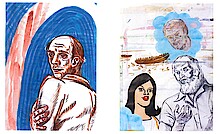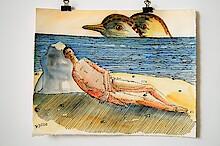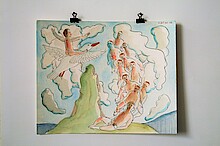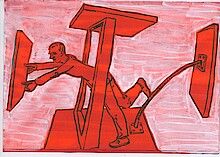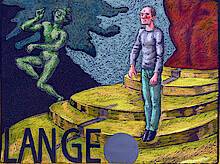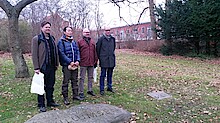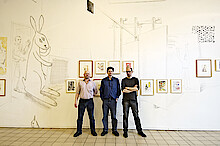Playful Dialogue in Time and Space
14 April - 19 August 2018
The exhibition is an artistic dialogue and play between Holger Bunk, Lars Ravn, Tong Wang and Helgi Thorgils Fridjonsson and two artists of the older generation. At the younger generation of the exhibition, now even between 50-60 years, there is a curiosity and urge to challenge itself in new constellations. The four artists meet again and again whenever possible and let their own art challenge and interact with the colleagues' art. In fact, in 2006, they also began to create pictures in common. There are also examples in this exhibition in the form of several completely fresh wall drawings.
The works of art are materially rooted in what can be done on paper: printed or drawn in different forms. Colorful or black and white. The drawing, traditionally often perceived as a preamble to what you see as the actual works – the oil paintings - constitute the main material at the current exhibition. Conversely, displaying ones drawing art is not a matter for the inexperienced, but for the hardened experienced artist who is not flinching. He or she can with the experience of safety make his impacts with precision.
It is also this experience that makes it possible for the artists, quite a few days before a deadline under such pressure, to dare to take on the making of quite large works, even jointly created directly into the exhibition. The artists here have in common that in their works there are motivational clues, something recognizable that a viewer can anchor by and use as a point of attachment for the connection with the image. In spite of many differences, they have the picture story - the narrative - as a merging of interest.
The image and the artistic practice is an ongoing process and breath for the individual in this group, which is not a group in that sense, but a circle of adult playmates. Their practice is a way to deal with life and the world, which, as a refreshing by-product, delivers a large number of beautiful picture stories to the outside world, so through these artists we are reminded of how diverse the world is at all levels.
For Tong Wang, the culture between East and West is a theme he continually processes in his art. It is of the deepest concern for him to reconcile the best of the cultures from the East and the West. In addition, his often synthetic works contain a dialogue with the present and the present. Like Tong Wang, Holger Bunk has a picturesque approach to the image, where the colors represent the deepest mental darkness and the brightest hope. They are carefully selected and tuned. Holger Bunk's picture stories are strong, existential, in a Danish context, to compare with Svend Wiig Hansen's people in limbo. Lars Ravn has gradually developed a personal visual alphabet with a number of characters and figures. His drawings are typically characterized by multiple layers, where the color, shapes or patterns dominate in the background and more figurative elements control in light lines above. The interaction between these creates a physical and mental room with plenty of space. The artist is experimenting with new image formats in the Chinese culture meeting, intensified by his settlement there in recent years. At Helgi Thorgils Fridjonsson you can see a formative language that at one time is unique to him and delicately incorporates inspiration from the best in graphic traditions. Motivically, Fridjonsson unfolds a unique interaction between stylized animal motifs from the near and nature world with the iconography of art history and partly commonly known story.
Danish J.F. Willumsen created when he was between 50 and 60 years of age, a large number of powerful graphic workers dealing with themes such as war (War invalids, The Invasion), people types (The Watercarrier in Taormina, The Wives on the Evian Market, The Old Street Singer, Negro Girl, The Conductor) and portraits (Edith, Mayor Marstrand, Councilor Philipsen). These and more original etching can be seen at the exhibition.
In this enormous undercurrent of narrative power, younger artists find considerable inspiration. At the same time, they mirror themselves in Willumsen's completely undaunted practice of and urge to acquire new skills regarding artistic means of expression – throughout his life. Qi Baishi was a Chinese artist, known for his quaint and playful style in his watercolours. Like Willumsen, he lived to a very old age, and he also stood out on the art stage as a very unique figure. In the exhibition, reproduction also shows examples of Baishi's works performed during his 50-60 years.
Being a mature artist not only involves the ballast of experience and the acquired knowledge, but also continually keeping the fire, curiosity and the ability to play alive, so the artwork continues to have a nerve and connection to life and contemporary life. The term “homo ludens”, the playful man, was formulated in 1938 by J. Huizinga in his book of the same name. Here, he argued that both myth, ceremony and cultural phenomena are rooted in the play. And that human survival is associated with being able to play. That's what these artists are doing too.
The exhibition "Playful Dialogue in Time and Space" can be experienced at the KunstCentret Silkeborg Bad on 14 April - 19 August 2018.

